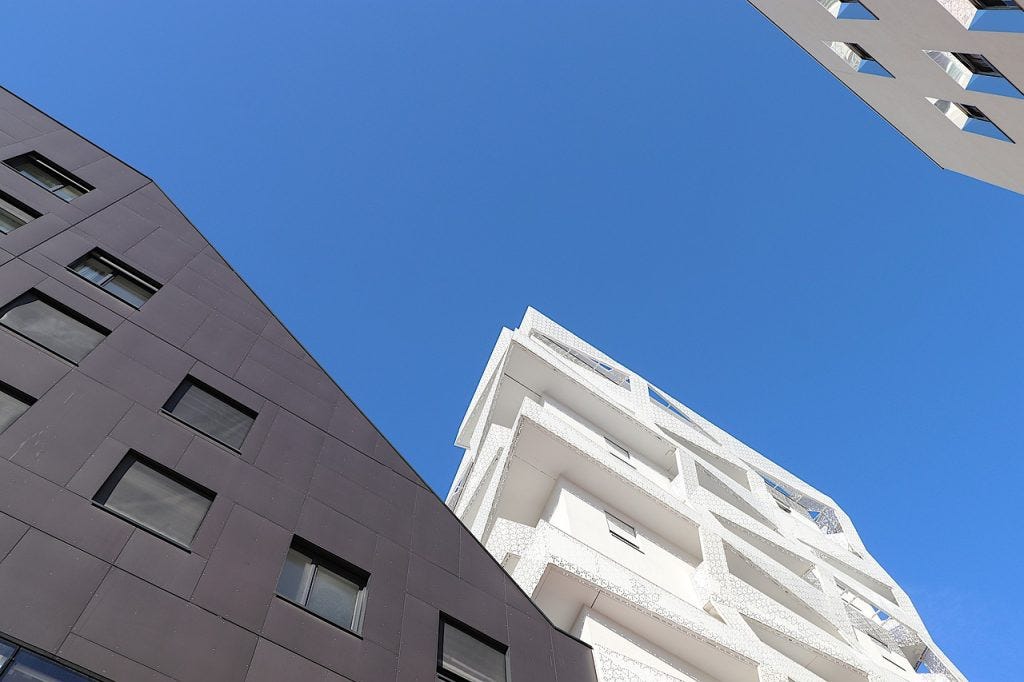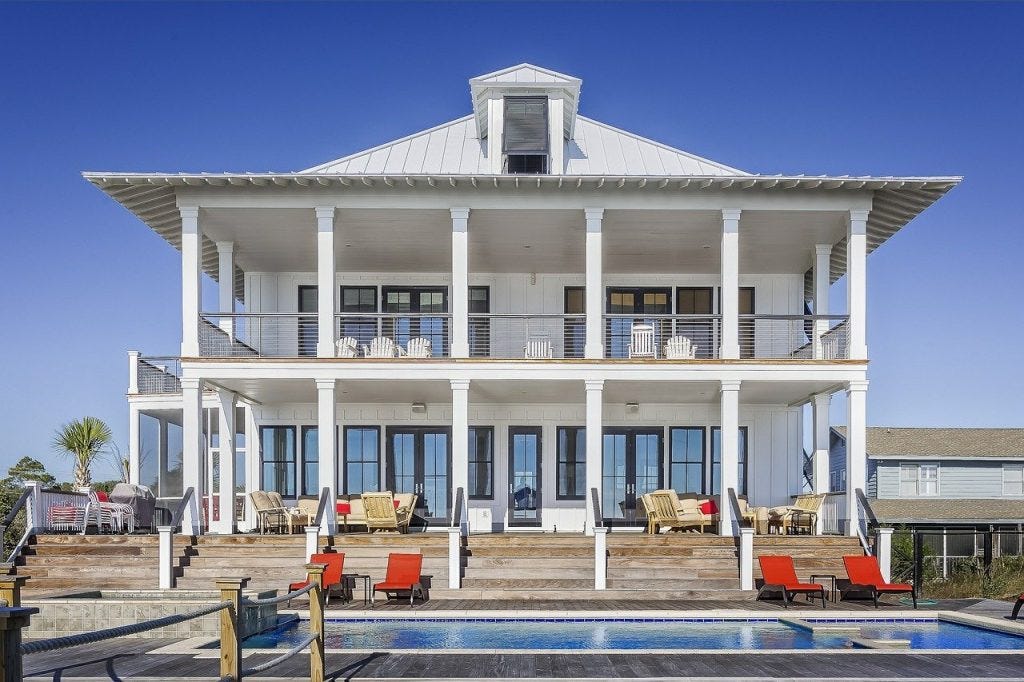Many new projects come along with big promises to disrupt another industry. Some have potential while many others are more hype and empty promises. One project that promises to create an entirely NEW Industry is Auto Construction & Block Members.
Proof of work is well known in blockchain but if you want to see proof of work, what better way than to build green buildings with a rapidly assembled IOT tracked block system. Each component block is registered to a digital twin counterpart (NFT). Talk about proof of work that speaks for itself. Auto Construction is serious about making blockchain (and its corresponding block supply chain) literal as much as revolutionary.
Deconstruction Will Soon Overtake Demolition
Tons of waste are created with each building demolition. With each one comes a price paid by the economy and environment. The life cycle of a building is 25-50 years. A small demolition can generate over 20 metric tons of waste and requires major cleanup trucking and labour costs. Over the past decade, demand for construction has flourished like never before which also implies heavy economic and environmental costs.
Re-constructible buildings are new, but they are economic enough to be here for the long run. Re-use structures can be as diverse as recreational cabins that could relocate to keep childhood memories alive, or as large scale as mine processing facilities that can be cleanly removed when the mines close.
The BIM Concept
6D Building Information Modeling (BIM) refers to the intelligent linking of individual 3D CAD components or “assemblies” allowing for the deployment of ‘puzzle piece blocks’ that fit together like Lego. Auto Construction creates a unique system of large self-complete, stacking blocks. In the Re-Use system, Blocks can be assembled and disassembled, a building can now be relocated or rebuilt with another layout using the original blocks. Wall surfaces and internal services are interchanged for replacement when a design becomes outdated. Easy services enable relocation of kitchen or bathroom services.
Construction 2.0 is also tokenizing the supply chain, disrupting a $10T a year construction industry and putting money back in people’s pockets. Just imagine, futuristic construction. Smart, green homes will be built by smart machines using AR, LoRa beacons, BIM, Blockchain Digital Twins (NFTs), and IoT. All these are uniquely integrated to run construction rapidly and with minimal human oversight. Tradesmen will still be required to provide services such as electrical, communications, security and plumbing installs.
The Mission & Vision
AC team and Partners have decades of experience in construction and its support industries. Profits are a main driver in construction. AC will provide one of the most cost-effective building solutions in history. Buildings designed for hurricane, fire and flood protection with the highest durability standards. Interior and exterior finishes are designed to be easily adaptable. Auto Construction is travelling in uncharted waters, creating new technology and new opportunities. This can be a life changer that people can be a part of simply by joining what may be the best ICO for 2022 or even a decade.
Furthermore, deep world demand awaits. Multinationals, franchisees, governments, Non Govt Organizations, and other large players are waiting for AC systems to start operating.
AC Block Members’ unique concept has been well received in diverse groups, wherever it has been introduced. Following the overwhelming feedback AECROS is receiving, no doubt this is fast becoming a hot ICO. Houses can be built within a week. Interior designs and outer finishes are endless and can be interchanged far into the future.
Now you understand the world’s newest industry, you are ahead of 99.99%.
Non-payments and time delays due to payment issues are widespread in the construction industry. Delays cost time and sometimes even cause catastrophic project failure. These factors must be eliminated to derive maximum efficiency from deployed capital. AECROS development of blockchain contracts allied with modular construction provides new and exciting solutions to these questions.
Blockchain enabled contract management
Security is blockchain’s main strength by allowing digital information to be distributed without risk of being hacked or stolen. Smart contracts are blockchain based agreements similar to real life contracts but in digital form. The main feature is established trust between parties through automatically executed payment for proof-of-work submitted.
A smart contract protects clients, contractors, subcontractors and suppliers against insolvency of late payments. They can even be intertwined with each other to create automatic top-down flow of payments for completed milestones, for example, a verified building completion triggers an automatic payment to the general contractor that triggers a subcontractor and suppliers’ auto payment. This sets the precedent for trustworthy contracts while removing the need for middlemen and payment and cash flow problems.
AECROS plans include the development of new blockchain contracts for smart payment in the construction industry. Payment guarantees and disbursement applications will create speed and reliability in these problem areas. Infrastructure service, Blockchain and other Software are required integrate to complete the system
AECROS system architecture containing blockchain and software form the foundation for system development. Finally, based on the system architecture, a prototype system is developed using both AECROS construction system modules and the BEX. This system can improve certainty and efficiency of the financing and construction logistics eliminating trust issues by enabling automated contracts in construction.
Future development will continually improve these systems and further streamline Auto Construction. For more insight into the problems facing construction today:
5 challenges the construction industry is facing in 2021
The AECROS component system is designed to do a lot of new things that ordinary construction can’t match for anywhere near the same cost.
Construction 2.0 will also do a lot of things we already expect with state-of-the-art construction, just better.
First some of the ordinary things the system does.
The components have interchangeable facings, to provide unlimited finishing options just like conventional construction. These structures will surpass the most stringent city building codes including envelope, fire and seismic (earthquake preparedness). Components offer high levels of insulation, moisture and thermal control…and this is where they begin to exceed standard construction…
Superior Building Control
Insulative and thermal transfer units can be upgraded or replaced, to provide ideal levels of energy savings, quiet comfort and efficient maintenance. The system not only provides for huge thermal mass, but makes it accessible with selective thermal coupling, bioclimatic controls, integrated hydronics and control systems. This is very important since thermal mass can also work AGAINST the desired climate control if not managed correctly. Using selective thermal transfer, in floor hydronics and positive pressure rapid air ducting, the interior climate control can be elevated to a whole new level of comfort and energy efficiency.
Mobile Services And Walls
Service areas are available to assist retrofit and individual customization. This means you can easily move services like kitchen or bathrooms to new locations without destroying the home. Service conduits are subsurface throughout the entire building.
Some walls will be mobile to make rooms bigger or smaller without modifying structural elements. Some entry areas and other rooms can also be adjusted depending on the original architectural specifications.
Disaster Resistance
These buildings cannot burn, they can’t fall down and they certainly won’t be touched by hurricane winds or heavy rains. They are monolithic poured, steel reinforced and blast resistant. These buildings wills save lives, even if we never know how many.
Digital Twin -NFT
Despite all the new construction and housing features we are mentioning here, one of the most exciting features of all is the digital twin aka “NFT”.
In simple terms, the Digital Twin is a building component NFT. The NFT provides a transparent engineering record, specifications, model number, IoT tracked location, and even more important for traders and first-time homebuyers, a monetized value.
How Could This Affect Home Ownership?
Imagine a prospective home buyer saving for years while the value of the homes they want rise. A $50k down payment was once sufficient but, in many locations today, it’s simply not enough anymore. With gradual ownership, Block/NFTs are a monetized building unit for as little cost as $500 each. This is a small achievable step and creates immediate partial ownership of “a piece of a home”. This is easier entry for many people who need homes.
BEX Trade
Now imagine these NFTs being convertible to trade, or as the starting point to home ownership. Now you understand the reasoning behind the BEX Home and Construction Financing. Homes and construction projects can be financed and traded, while construction supply and logistics are streamlined at the same time. Steady growth of Members holdings on the exchange could translate into years shorter payments toward their homes. The Exchange can actually work to help home owners pay for their homes faster.
From Blockchain in Construction 2.0, the Block Exchange “BEX” providing Home and Construction financing plus Members NFT trading, the MP token unites them all. Owning a home is about to get a lot easier, in the near future people will be “HODLING” homes and component NFTs as Crypto Homes… amazing hybrid solutions that are coming to change housing forever.
What Auto Construction does is to enable mass production of building components and utilize many existing (and upcoming) technologies for the streamlining of Architecture, Engineering, Construction, Real Estate Financing and Sales industries.
AEC(R) OS & Auto Construction
Auto Constructions AECR Operating System engineering continues to design new inventions in a self-complete building system resembling giant, stone finished, self-complete LEGO units.
The many standardized features of this system (insulation, service passages, structural features) enable rapid production and robotic handling of the units (MBUs) to assemble complete smart buildings of a highly desirable nature, economically, structurally and ecologically. In addition to the ordinary features of resistance to fire, flood and hurricanes, these buildings also utilize a selectively thermocoupled mass within the envelope to assist with bioclimatic architecture. The Auto Construction building system offers new capabilities for passive and active bioclimatic designs. These homes will be heated utilizing (in addition to other things) the waste heat of data processing terminals.
Computer “hash power” creates a good use of power overages produced within the highly efficient power network distribution system. The decentralized power and data processing offer additional networked data processing capabilities to assist AI, IOT, BIM, Robotics and other advanced systems operations. In the real world a high demand for these types of structures (Homes, Commercial and Industrial buildings) already exists.
The BIM Process
Quantum computing AI uses point clouds created by flying Drones and IOT LoRa beacons within machines and building blocks (on site and in transit), uplinked by satellites to BIM cloud (and blockchain) and fed into the Design Architecture, Building Software and Blockchain Financial Systems. Data points create Augmented Reality (and phase space) and populates the Building Information Management Cloud for AI assisted human interaction through the AR/BIM/Phase Space environment. The human assisted by AI completes a desired design and the system makes a query to the financing application which sends its qualification parameters to the BIM /NFT token enabled System to show allowable budget, costs and contracts and interacts with BIM and BEX to create project approvals and scheduling to the prospective building owner.
This enables the human to adjust their decision making and adjust building design parameters to fit their own requirements. Upon design completion the AR allows the human (wearing goggles or accessing a computer or smart device) to walk through the actual building site, or virtual representation of it, while seeing the virtual building features in real time and space. The final inspection and approval then allow the building scheduling to begin.
Upon acceptance by all parties, the components requirements are sent to the manufacturing network to adjust inventory. Simultaneously the required building components are shipped to the building location from nearest available inventory.
Machines and crew are dispatched to site to begin site preparations and interact with AR and BIM throughout building process. System creates required scheduling and cranes dispatch to site to arrive with inventory, IOT and LoRa beacons provide real-time tracking data to the logistics portion of the BIM systems. Robotic cranes utilize phase space, IOT and BIM to erect the buildings. Upon completion the final trades complete ancillaries and finishing touches to architecture and property. A final walk through and cleaning is conducted. Final inspection for occupancy is issued and upon receipt the real estate agency receives property listing and 3 D walk through or in the case of presales the occupants take possession.
This will be the first “Drag and Drop” building application in the history of Construction. (“Drag and Drop” applying to both the virtual and the physical worlds.)
The greater the project demand fulfilled, the more efficiently the system will operate both from the perspective of technological and data processing capabilities but also by increasing economies of scale, streamlined manufacturing and transport logistics. Robotics systems (and Blockchain) continuing development and (time) improved AI machine learning will also enhance the systems efficiencies.
The more “exercise” the system and the AI gets, the more efficient it becomes both economically and through enhanced speed in both the digital and physical world. This is in direct opposition to the traditional construction method and AEC industry, where greater volumes more often result in reduced profit margins and decreasing efficiencies as the workload increases.
Automation of the architecture, engineering, financing and construction processes is a new and largely untapped frontier. AC will enable growth and demand for many technologies as we achieve mass adoption.
In today’s construction many projects over-run their budgets before they are even halfway through. Contrast this to the automotive industry where every car has a pre-determined sticker price prior to purchase. No one should get a nasty price shock after paying for their purchase!
In the area of building renovations, the initial budget estimate often leaves the project owner returning to the bank for additional financing. This is far too common today. It is easy to see that the way forward is mass production as in the automotive market.
Even expert contractors often order materials, only to discover that the project is short of material. The truth is there’s hardly a company or contractor out there that this hasn’t happened to. Time is our most asset, and it is commonly wasted as contractors are delayed and required to pick up more materials. Automation and component systems solve these problems.
Automated Construction: Modular Block System
Block assembly as a concept is in fact very logical way to repair our slow, expensive and environmentally damaging construction industry. Block design AND assembly removes issues such as cost overruns, theft of materials, schedule delays due to errors, financing delays, environmental damage and even project cancellations. Automated construction creates end-to-end streamlining of the process from design and financing to laying the last block.
Since the overall project is designed with blocks, the software can fit these together like a puzzle. Additionally, thanks to the advent of blockchain, ledgers can be recorded tamper free. Future access then provides exact specifications from these NFTs. ERC 721s or ERC 1155 tokens can be traced to origin. This data feeds smart cranes and augmented reality (AR) to create and handle engineering standardization.
The world can now witness construction speed and affordability on a previously unknown scale.
Four Levels Of Operations In Aecros
Firstly, there are builder robots or “drones” for heavy lifting and stacking. Secondly, the Block Exchange Platform brings crypto financing opportunities to members who can instantly access on-chain funding. A third area is Architectural design. Architects can create NFTs of building plans and their blueprinted IP can be safely stored on the Ethereum network. Lastly is factory production and delivery. Block supply is based on production. Production is based on member block purchasing on the exchange, factories match these as production orders. 1000 blocks are enough building a 2800 sq ft house. When a client, for example State Farm, decides to rebuild a group of storm damaged homes, these orders flow into the BEX (Block Exchange) and existing blocks are rapidly delivered to the building sites. Block Members have access to the Block Exchange to benefit from the resulting Block/NFT trade orders.
From the beginning of production, demand will outstrip supply until shipping can deliver. This will naturally create waiting lists. Member Placeholders will hold these critical supply positions on the exchange. There is no artificial scarcity being created here.
Construction Demands Speed
Did you know that every passing day a new Walmart store is under construction, over a million dollars in earning potential is lost? AC systems are designed to drastically cut the build time. This will save clients many millions in lost revenues per project.
The greater efficiency of block production not only saves wasted material but also saves a lot of time.
Consider how much extra money will be saved by completing building projects 50% sooner. This doesn’t sacrifice quality. These cutting-edge buildings are designed to resist fire, floods, and disasters. The public will certainly need to Whitelist for Crypto Investment while supplies last.
With all things considered AECROS has a bright future as they begin to revolutionize a $10T a year industry.
Learn about the Best crypto investment
Jeromeon
Trust in the contacting industry is earned over time, but time is costly. Blockchain brings the solution: zero knowledge proofs.
Anyone who has dealt with an unknown contractor already has some knowledge of the trust issue. Some contractors collect deposits and drag out your deadline only to enrich themselves, while some genuinely complete the work, and there are many shades in between. The elephant in the room is that many projects end poorly.
Even large firms can hardly avoid cost overruns and timeline delays by using established contractors. Construction supply traceability and accountability are lacking. Many contracts pit contractors against clients over job estimates and missed deadlines.
Supply chains suffer numerous challenges in terms of deadlines and budgeting. According to a survey conducted by IHS Markit, “Construction projects experience a 10-30% delay in meeting deadlines and up to 20% cost overruns, in some rare cases up to 50%.”
Below is an excerpt from AECROS / AC White Paper:
Previous studies have shown that mutual trust helps to smooth the construction process, allows flexibility for facing uncertainty, increases efficiency and sustains long- term relationships. In practice, formal contractual rules are always developed to legitimise behaviours and strategies at odds (Kadefors, 2004). However, current contractual relationships are mainly based on confrontational situations that reflect the level of trust (or mistrust) in the contract documents, which can be the driver to increase the total cost of a specific project (Zaghloul and Hartman, 2003).
Today’s methods of contracting and use of construction technology are inadequate. Data exchange is slow and needs a new shared space to meet market needs. Modern construction technology simply creates too much error, wasted material, time, money and loses unearned potential revenue.
The Auto Construction industry is focussed on market needs. AECROS fills the gap with a tokenized construction supply chain. Construction 2.0 now becomes fully automated with advanced technology. With a mix of BIM, blockchain, AI, digital twins, 5G, LoRa beacons, IoT for auto inventory tracking, AR/VR, RFID, fintech and more, Automated construction will rebuild contractual trust, save economic and environmental costs. Project build times can be reduced by more than 60% with blockchain enabled contract management.
Security is one of blockchain’s strengths, allowing digital information to be recorded without risk of being changed. Smart contracts are blockchain based agreements like real life contracts but in digital form. The main feature is established trust between parties through automatically executed payment for proof-of-work submitted.
A smart contract protects clients, contractors, subcontractors and suppliers against payment issues. Escrow can be held, and later released for completed milestones. This sets the precedent for trusted contracts while removing the need for middlemen.
In conclusion, trust needs to be restored in construction. Blockchain has soared in the use of smart contracts with over 7000 communities using it to foster open communication and trust.
If there is to be full trust-based accountability, reliability, and KPIs, superior technology and methods must be implemented. Trust can be achieved using blockchain technology to overcome contract issues, this saves time, money, and fosters good relationships. We can all use more good relationships.
Author: Jeromeon
At time of writing, the cryptocurrency global market valuation is just slightly above $250 billion, while the construction market is in excess of 10 trillion annually.
Construction enters uncharted territory as the industry is backed by real-world assets with a practical utility such as construction and real-estate.
AEC: The Architecture, Engineering, and Construction industry is one of the largest global sectors waiting for disruption by blockchain technology.
A tokenized housing market can increase real-world adoption of crypto currencies and blockchain. This disrupts a 10 trillion-dollar annual industry.
Block Members are supporting the Auto-Construction industry through the Membership Placeholder token. The MP authorizes individuals to partake in a “first of its kind” industrial revolution. History is being made.
What is Block Members?
Block Members uses a reward-based system to offer everyone the opportunity to shape the future of home building. With a team of contributors and investors, Block Members boasts of a track record of research and development in Robotic software Systems and Construction Development going as far back as 1980. Many partners and advisors joined accidentally as field experts were asked to review aspects of the technology, they often joined the ACBM.
Block Members supports and benefits from the Automated Construction industry. This will be achieved through a multidisciplinary approach called AECROS AKA Architecture, Engineering, Construction & Real Estate: Operating System.
Auto Construction will build homes many times faster than legacy construction
and at the same time producing zero waste. Even more importantly, a new home financing method will be created.
What is AECR: OS
AECROS is the operating system that combines different technologies to Automate Construction. AECROS engineers are creating a seamless and automated process of building affordable homes.
AECROS “Operating system” will use a combination of artificial intelligence, IoT, robotics VR, BIM & blockchain to create an autonomous home building process financed through a global token economy.
Industrial Revolution 2.0
The Auto-Construction Industry is powered by AECROS to build the intelligent smart homes of the future. Buildings emit almost half of the carbon dioxide in the US alone and construction typically wastes. 30% of the materials and associated labour. This comes at a cost to our environment.
Through participation Block Members can improve the ecological footprint of the construction industry, and change housing for the better.
Go here to whitelist and become a part of the housing revolution: https://autoconstruction.org/automation-and-tokenization-of-construction
One 25 yr engineering veteran says..
“These blocks or modular building units are likely the smartest construction system you’re ever going to see.”
Modular building units are self complete modules or buildings, resembling giant lego.They perform tasks with which ordinary construction simply can’t compare. And cost isn’t anywhere near as expensive.
Firstly, let’s begin with the ordinary tasks MBUs can perform. They provide unlimited finishing options, structures that pass city building codes, fire codes and seismic (that’s earthquake preparedness). Beyond the ordinary, MBU’s offer high levels of insulation and thermal mass. Insulation and thermal transfer units can be upgraded, thinned or replaced, to provide ideal levels of energy savings and tranquil comfort Whatever the needs and preferences of the customer are, they will be built to tolerate any climate.
The service areas are available for retrofit and individual customization (this means you have the ability to redesign, redecorate and restructure your bathroom, dining room, kitchen, etc). Some walls are mobile…so you can make your kitchen or living room bigger and the bedroom smaller (or vice versa).
Then we just simply have to mention huge thermal mass (with selective thermal coupling), bioclimatic controls, integrated hydronics and fire suppression systems. These components cannot burn, they won’t fail because they are disaster proof, so remain fully functional during a hurricane or heavy flood.
Interior environment control elevates to a whole new level of comfort, efficiency, safety and security. Solar panels are integrated and feed the data processing furnaces. Think of a giant computer in your basement, heating while it earns crypto or processes data. In spite of all the new construction and housing features we are talking about here, the most exciting of all for this construction ICO 2020 – the digital twin.
In layman’s terms, the digital twin provides a secure and transparent engineering record, specifications, model numbers, IoT tracked location and positioning, and even more importantly for traders and first time home owners, is a monetized value.
What this could mean for home ownership?
Imagine yourself saving slowly for years, while the value of the home you want is constantly rising.
That 50k you saved looks pretty good had you saved it years ago. In many neighborhoods today, not a chance. What if you could walk away with the keys to your own automated construction MBU home for just $50k?
Now imagine, this being convertible to trade, or as the starting point to owning your own home. You could buy, sell or flip homes by using the Block Exchange. This adds a solid use case behind the BEX DApp. Yet another cool feature of blockchain in construction 2.0, the block exchange DApp is being designed. It will enable home financing, to protect block members and a slew of other advantageous features members need for their convenience.
Thank Blockchain, IoT, robotics, mass production, LoRa beacons, AI, automated machines, and many other smart inventions. Owning your very own home is about to get a lot easier. Since we’re about to be ‘holding’ homes, crypto just got better too.
In case you don’t want to miss out on the rise of Construction 2.0…
Visit www.blockmembers.io
And join us in reshaping a $10T annual industry. Learn more about Blockchain Construction and Membership Placeholder
ACBM is poised to disrupt a $300T real estate industry. Obviously, a project this ambitious can be highly technical. For those readers who wish to dive into a few details without all the jargon, this is for you.
Finite Element Analysis (FEA)
FEA is the simulation and analysis of any given physical phenomenon using the numerical technique called Finite Element Method (FEM). Engineers use FEA to lessen the building of excess prototypes. This reduces trial and error to quickly create better components during the design stage. FEA relies on mathematics to resolve the impact of separate particles, elements and objects interacting with each other within a simulated environment. For each construction project to be undertaken FEA can be used to determine how to create a complex architectural design. The designer works more efficiently, saving a lot of trial and error. Resulting costs are less, while accuracy is maintained.
According to Siemens, “To simulate the effects of real-world working environments in FEA, various load types can be applied to the FE model including nodal (forces, moments, displacements, velocities, accelerations), elemental (distributed loading, pressure, temperature and heat flux), as well as acceleration body loads (gravity). Types of FE analysis include linear statistics, nonlinear statics and dynamics, normal modes, dynamic response, buckling and heat transfer.” FEA is one Universal System with multiple benefits.
Monetized /Modular Building Units (MBUs)
MBUs hold unique value because they divide the construction process into self-complete units. These units provide surface finishes, plumbing, heating, electrical installation, structural integrity and seismic preparedness and more. Each MBU is a uniquely identifiable NFT that ties into block chain through IoT. MBUs can be quickly assembled by robots. Specialization of construction tasks and division of labour allow any size building to be constructed by the new AECR Operating System. Fintech enables these MBUs to be traded on the Block Exchange as a ERC 721 or an ERC 1155 token (NFT). Thanks to the Block Exchange, Blocks can be efficiently traded and supplied as a commodity. Members can us MBUs to borrow, finance, flip, buy and sell units.
RE-USE-A-BLOCK
MBU self-complete building units can also be disassembled later for reconstruction at new building locations. Re-use saves time, material, environmental and resupply cost. Temporary structures can be assembled quickly for purposes such as rescue housing.
Overall, the system will enhance efficiencies across multiple fields to benefit the world in many ways.
1. Mass produced Modular Building Units (MBUs) integrate and enable a whole range of technologies: IoT, quantum computing, Building Information Modelling (BIM), artificial intelligence, virtual reality, 5G, blockchain, digital twins, design library, LoRa Beacon, Block Fund, RFID chips. The BIM connects with IoT to track inventory. Quantum powered computers connect over 5G WiFi to the blockchain and links digital twin building blocks to the RFID physical blocks. Once a project blueprint has been designed with virtual reality (VR/AR) and gets pulled from the design library, then a blockchain smart contract is drawn up on ERC-20 protocol. Next comes instant financing from the Block Fund. Finally, all the inventory is shipped from Block Members inventory to site. Materials and equipment get shipped to site. Super Cranes connect to LoRa Beacon for placement accuracy. The finished structure comes about within days or weeks and then can be traded at a markup for MP on the block exchange.

2. Get paid to hold real estate. By buying in now you’ll be paid in real estate when you cash in your MP tokens for an MBU or physical replica of your virtual reality house. By buying MP you are hodling a Crypto Home.

3. Build a 5000 Sft home with several bedrooms and bathrooms for 1400 MP. Buy 2000 super blocks, with as little as $200 invested today and enjoy up to 30% bonus.

you can secure your own Crypto Home for up to 60% cheaper than the original cost. It’s better to build a home as a block member. Members pay up to 5X less to construct a smart building than non-members.
4. Robotics will build schools, damaged buildings, rescue shelters, government offices through fully autonomous development of estate. Robotic construction will also aid in disaster relief. Temporary shelters can be deployed during times of natural calamity or humanitarian crises
5. Blockchain based technology to foster new-found trust amongst suppliers, contractors, and clients. Traditional construction has trust issues from which confrontation develops. The client distrusts the contractor and thinks he is ripping him off. The sub-contractor distrust the contractor and thinks he is poaching money from his sub-contracts. The labourers and professionals believe the sub-contractor is sneaking and pinching a piece of their pay rate, offering them a lower rate than the sub-contract stipulates. The supplier wants his pay to quickly restock but there is a delay from the contractor to pay on time and in full. Generally this web of distrust enables highly confrontational environments which can cost a project skilled personnel, time, and money. Ethereum smart contracts and crypto assets will replace the present method of contracting to create automatic top-down flow of payments for all parties upon approved review of submission of work. This will mitigate all cash flow challenges.
6. Future Proof Smart Buildings – It is important to maximize the value and utility of smart buildings. Crypto Homes are future proof with removable panels, easy service access and easily replaceable features. With Autoconstruction future upgrades can be made with minimal damage to structure. These save time and money while giving you the ultimate advantage in renovations. For example: To change locations of a plumbing fixture such as a shower, the base unit can be easily removed, the plumbing can be disconnected, and a new location chosen anywhere within the structure. In the old location, a single panel is replaced, bringing the surface back to new and eliminating former access holes to the service. In the new location, a panel is removed, and the fixture is connected. The entire operation can be completed in a few hours. In that amount of time living rooms, kitchens, bathrooms or an entire building service layout can be remodeled in no time without repairs and damages. Panels can be replaced once they become outdated.

7. Supply is extremely Limited. At the ICO only 120 million MP will be sold. That’s 33% of total supply. In other words 33% of the buyers will get MP tokens at a ridiculously low price of $0.10. They are guaranteed to fly off the shelf. This ICO is hot and trending so soon the price will increase. Get in early and you can hodl a home. Only 3% of the world owns crypto. This is very much still the early days for blockchain and fintech so waiting for 4 years for a construction technology startup to deliver Crypto Homes is the same as hodling for the next Bitcoin moon. Take a look at this website and you will see the price of 5000 square foot properties in the US and then you’ll understand why waiting four years is nothing at all. Even after 30 years of slaving away in a banker owned capitalism world, most people cannot afford one of these properties, which makes holding onto your Member Placeholder (MP) token worth it in the long run.
8. Tired of your neighborhood? Why not just pack your house on to a truck and move? Yep you guessed it. Your smart house comes portable and deconstructible, with super blocks that stack up similar to Lego plastic toy building blocks.
9. Anyone from anywhere will be able to lease a super crane. Super cranes are fully developed and will be ready for robotic site testing in 2022. Professionals will be out in the field to train contractors how to use Auto Constructors. They come with levelling tracks and are equipped to build across any terrain or weather.
10. Build green, build fast, build smart. Traditional construction just has too lackadaisical an approach to climate change and technology. Current construction methods are destroying the environment by releasing billions of tonnes in carbon-dioxide each year. Green buildings save the environment by having close to zero carbon emissions. Finally, smart buildings have interconnected conduits, easily replaceable window and door panels. You can easily rearrange some rooms without knocking out walls and this is so convenient because you can do a makeover after five years without having an expensive crew of workmen. All the noise, dirt, lack of privacy, disturbance to neighbours and inconvenience get reduced to a few hours thanks to technology. Is renovating a house after ten years something people do? Not really, but if you are a bit more adventurous then you now have that option. Now you can also easily. get playful and creative with real estate. Change interior layouts whenever you like.

11. Super Blocks Building System, hurricane homes, mega universal building system: a system of self complete buildings with accessible financing and mass production. Super blocks are leading three new industries; green buildings, tokenized real estate and mechanized construction. Each super block has a blockchain twin. Super blocks hold high standards and are hurricane, flood, fire and seismic proof.
12. By investing in Block Members ICO early you get up to 30% BONUS on any MP purchase. Minimum purchase is $200. MP can be bought with BTC, ETH, AMEX, PAYPAL, VISA, MASTERCARD, USD and EUR.

There you have the 12 cool facts about Block Members.
Author: Jeromeon
